MCP
在AI技术大火的当下,各个公司都在搞AI-Agent技术。对于Agent来说,其实还处于一个早期的阶段,没有所谓的最佳实践。更没有一些标准规则。可谓是一片蓝海。
大厂们也都在做着自己的一些尝试。但是总有人在建设底层规则。
MCP就是一个标准化的产物。它定义了一些标准。
Model Context Protocol(MCP)是由Anthropic于2024年11月推出的开放标准,旨在为大型语言模型(LLM)应用提供统一的上下文交互接口,使其能够与外部数据源和工具进行无缝集成。MCP采用客户端-主机-服务器架构,基于JSON-RPC 2.0协议,支持有状态连接和功能协商,允许AI模型访问文件、执行函数和处理上下文提示。
截至2025年4月,MCP已被多个AI平台和开发工具采纳,包括OpenAI、Google DeepMind、Replit、Sourcegraph等。其应用场景涵盖了软件开发、企业助手、自然语言数据访问等领域。
MCP服务器开发
许多大模型目前没有能力获取预报和恶劣天气警报。让我们使用MCP 来解决这个问题!
我们将构建一个公开两个工具的服务器:get-alerts 和 get-forecast。然后我们将服务器连接到 MCP 主机(在本例中,Claude for Desktop):
MCP本身提供了一些语言的SDK,包括:
- Python
- Node.js
- Java
- C#
- Kotlin
以Java为例,要求如下:
- Java 17 或更高版本
- Spring Boot 3.3.x或更高版本
使用SDK可以大大简化我们的开发过程,比如JAVA里面的,我们只需要一个注解@Tool就可以搞定了。
需要添加Maven依赖:
- spring-web:web开发依赖
- spring-ai-starter-mcp-server:MCP服务器开发依赖
<dependencies>
<dependency>
<groupId>org.springframework.ai</groupId>
<artifactId>spring-ai-starter-mcp-server</artifactId>
</dependency>
<dependency>
<groupId>org.springframework</groupId>
<artifactId>spring-web</artifactId>
</dependency>
</dependencies>
我们增加一个Service类,该类有两个方法,这两个方法提供了我们上面说的两个工具的能力。
- getWeatherForecastByLocation: 提供给Agent或者大模型的工具,输入参数是精度和纬度,根据经纬度获取天气预报。
- getAlerts:提供给Agent或者大模型的工具,输入参数是地区,获取该地区的天气警报。
@Service
public class WeatherService {
private final RestClient restClient;
public WeatherService() {
this.restClient = RestClient.builder()
.baseUrl("https://api.weather.gov")
.defaultHeader("Accept", "application/geo+json")
.defaultHeader("User-Agent", "WeatherApiClient/1.0 (your@email.com)")
.build();
}
@JsonIgnoreProperties(ignoreUnknown = true)
public record Points(@JsonProperty("properties") Props properties) {
@JsonIgnoreProperties(ignoreUnknown = true)
public record Props(@JsonProperty("forecast") String forecast) {
}
}
@JsonIgnoreProperties(ignoreUnknown = true)
public record Forecast(@JsonProperty("properties") Props properties) {
@JsonIgnoreProperties(ignoreUnknown = true)
public record Props(@JsonProperty("periods") List<Period> periods) {
}
@JsonIgnoreProperties(ignoreUnknown = true)
public record Period(@JsonProperty("number") Integer number, @JsonProperty("name") String name,
@JsonProperty("startTime") String startTime, @JsonProperty("endTime") String endTime,
@JsonProperty("isDaytime") Boolean isDayTime, @JsonProperty("temperature") Integer temperature,
@JsonProperty("temperatureUnit") String temperatureUnit,
@JsonProperty("temperatureTrend") String temperatureTrend,
@JsonProperty("probabilityOfPrecipitation") Map probabilityOfPrecipitation,
@JsonProperty("windSpeed") String windSpeed, @JsonProperty("windDirection") String windDirection,
@JsonProperty("icon") String icon, @JsonProperty("shortForecast") String shortForecast,
@JsonProperty("detailedForecast") String detailedForecast) {
}
}
@JsonIgnoreProperties(ignoreUnknown = true)
public record Alert(@JsonProperty("features") List<Feature> features) {
@JsonIgnoreProperties(ignoreUnknown = true)
public record Feature(@JsonProperty("properties") Properties properties) {
}
@JsonIgnoreProperties(ignoreUnknown = true)
public record Properties(@JsonProperty("event") String event, @JsonProperty("areaDesc") String areaDesc,
@JsonProperty("severity") String severity, @JsonProperty("description") String description,
@JsonProperty("instruction") String instruction) {
}
}
@Tool(description = "Get weather forecast for a specific latitude/longitude")
public String getWeatherForecastByLocation(
double latitude, // Latitude coordinate
double longitude // Longitude coordinate
) {
// 使用 RestClient 发起 GET 请求,获取指定经纬度的点信息
var points = restClient.get()
.uri("/points/{latitude},{longitude}", latitude, longitude) // 构建请求 URI,替换占位符为具体的经纬度
.retrieve() // 执行请求并获取响应
.body(Points.class); // 将响应体解析为 Points 类型的对象
// 使用 RestClient 发起 GET 请求,获取点信息中的天气预报 URL 对应的天气预报数据
var forecast = restClient.get()
.uri(points.properties().forecast()) // 从点信息中提取天气预报 URL
.retrieve() // 执行请求并获取响应
.body(Forecast.class); // 将响应体解析为 Forecast 类型的对象
// 遍历天气预报的各个时间段,生成格式化的天气预报文本
String forecastText = forecast.properties().periods().stream().map(p -> {
return String.format("""
%s:
Temperature: %s %s
Wind: %s %s
Forecast: %s
""",
p.name(), // 时间段名称
p.temperature(), // 温度值
p.temperatureUnit(), // 温度单位
p.windSpeed(), // 风速
p.windDirection(), // 风向
p.detailedForecast()); // 详细天气预报
}).collect(Collectors.joining()); // 将所有时间段的天气预报文本拼接为一个字符串
// 返回生成的天气预报文本
return forecastText;
}
@Tool(description = "Get weather alerts for a US state")
public String getAlerts(
@ToolParam(description = "Two-letter US state code (e.g. CA, NY") String state
) {
// 使用 RestClient 发起 GET 请求,获取指定州的天气警报信息
Alert alert = restClient.get().uri("/alerts/active/area/{state}", state).retrieve().body(Alert.class);
// 遍历警报信息的特性列表,将每个特性格式化为字符串并拼接为最终的警报信息文本
return alert.features()
.stream()
.map(f -> String.format("""
Event: %s
Area: %s
Severity: %s
Description: %s
Instructions: %s
""",
// 获取警报事件名称
f.properties().event(),
// 获取警报影响区域描述
f.properties.areaDesc(),
// 获取警报严重程度
f.properties.severity(),
// 获取警报详细描述
f.properties.description(),
// 获取警报的操作指令
f.properties.instruction()))
// 将所有警报信息拼接为一个字符串,以换行符分隔
.collect(Collectors.joining("\n"));
}
}
再通过MCP提供的MethodToolCallbackProvider 工具类来将 @Tool 标记的方法转换成统一的方法,对外部提供工具。
这是因为MCP服务器规定要给外部提供统一的接口、返回值、参数。所以要转换成符合MCP规范的接口。
@Bean
public ToolCallbackProvider weatherTools(WeatherService weatherService) {
return MethodToolCallbackProvider.builder().toolObjects(weatherService).build();
}
接下来构建服务器,运行成功以后,会在target目录下生成一个jar包,运行该jar包应该能成功启动:
./mvnw clean install
接下来我们无需启动这个jar包,直接使用Claude 桌面版客户端即可。
可以在这里下载:claude 桌面版下载
下载以后,打开应用,登陆上去,选择 Claude -》 Settings
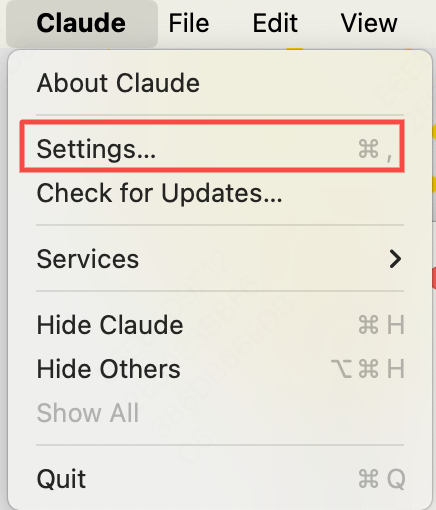
选择Developer -〉Edit Config。会自动创建一个MCP的配置文件。如果已经存在了则不会创建。
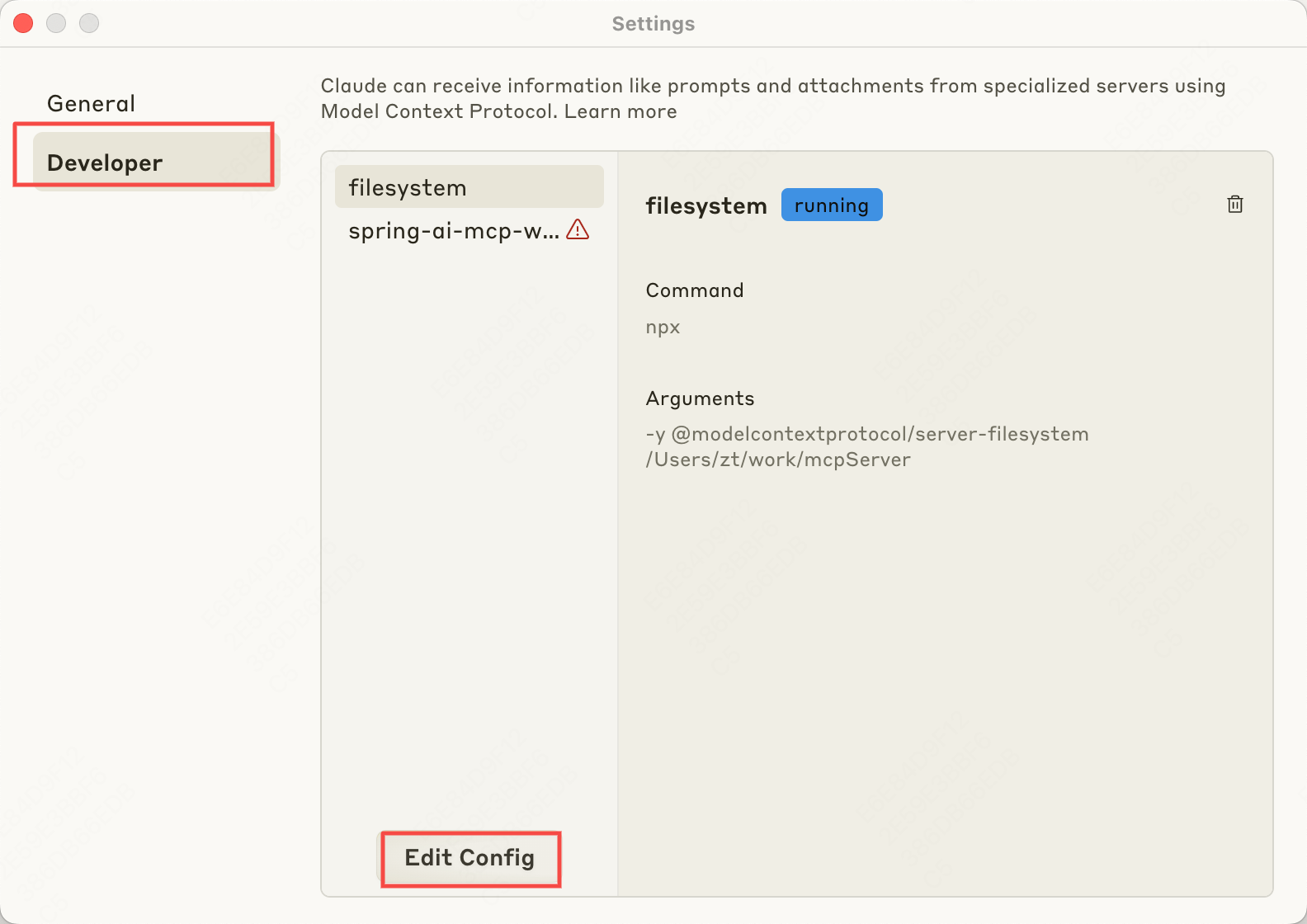
创建的配置文件名称如下:
claude_desktop_config.json
修改这个配置文件,内容如下
{
"mcpServers": {
"spring-ai-mcp-weather": { // MCP服务器名称,可以随便输入
"command": "java", // 使用java命令启动MCP服务器
"args": [ // java后面跟的参数
"-Dspring.ai.mcp.server.stdio=true",
"-jar",
"/mcpServer/target/mcpServer-0.0.1-SNAPSHOT.jar" //jar包的绝对路径地址
]
}
}
}
接下来重新启动Claude桌面版即可。在启动Claude的时候,Claude会根据上述配置文件来启动MCP服务器。启动命令类似:
java -Dspring.ai.mcp.server.stdio=true -jar /mcpServer/target/mcpServer-0.0.1-SNAPSHOT.jar
如果通过jps命令,可以看到jar包启动成功。
jps -l
在Claude桌面版上可以看到我们刚刚配置的MCP服务器名称和提供的工具。
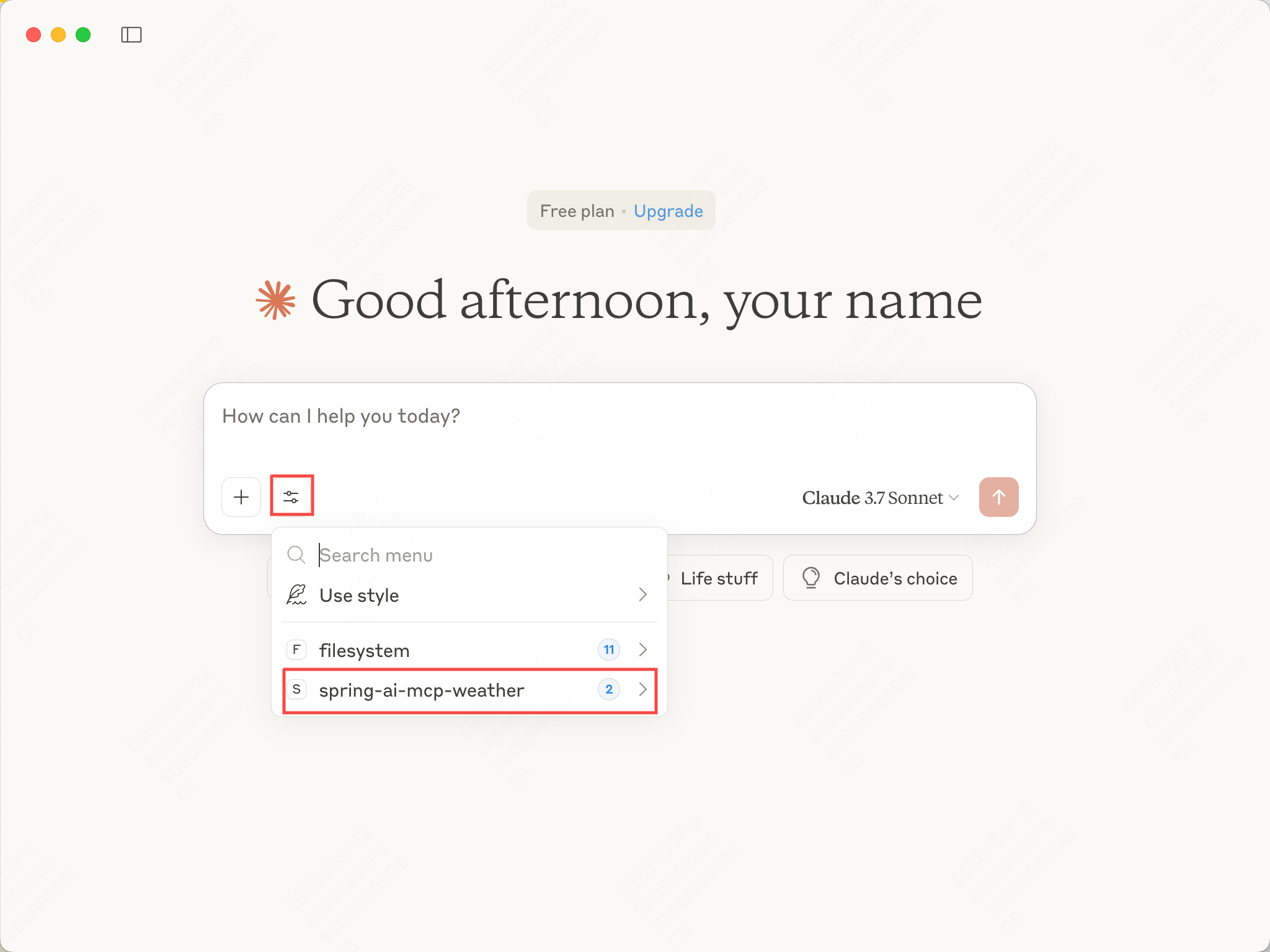
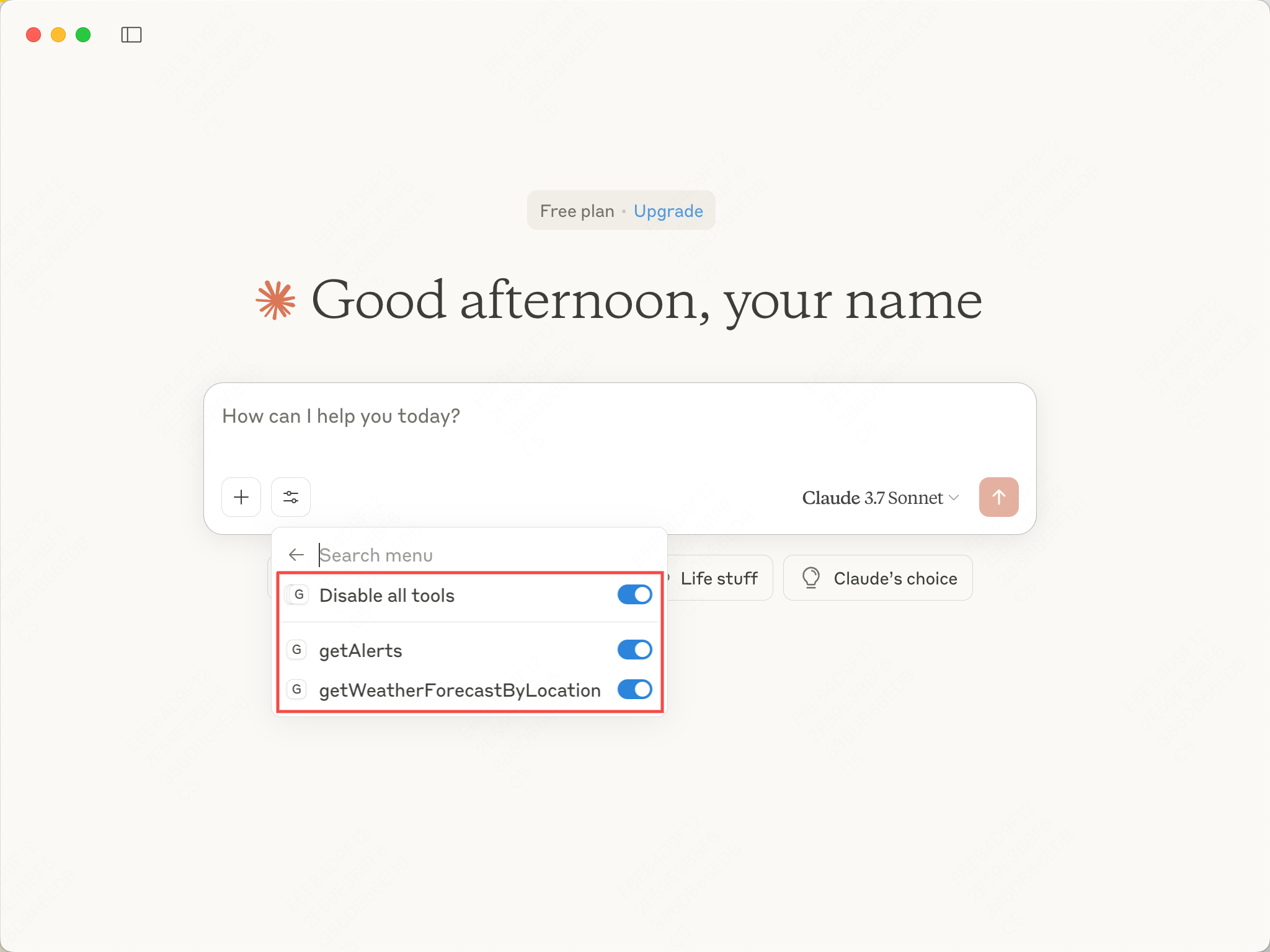
可以自主启用和禁用工具。
接下来我们和Claude大模型交流的时候,大模型会自己判断需不需要调用工具,调用哪个工具,如何调用。当调用的时候,会让你进行确认。
来试试输入:
纽约的天气怎么样?
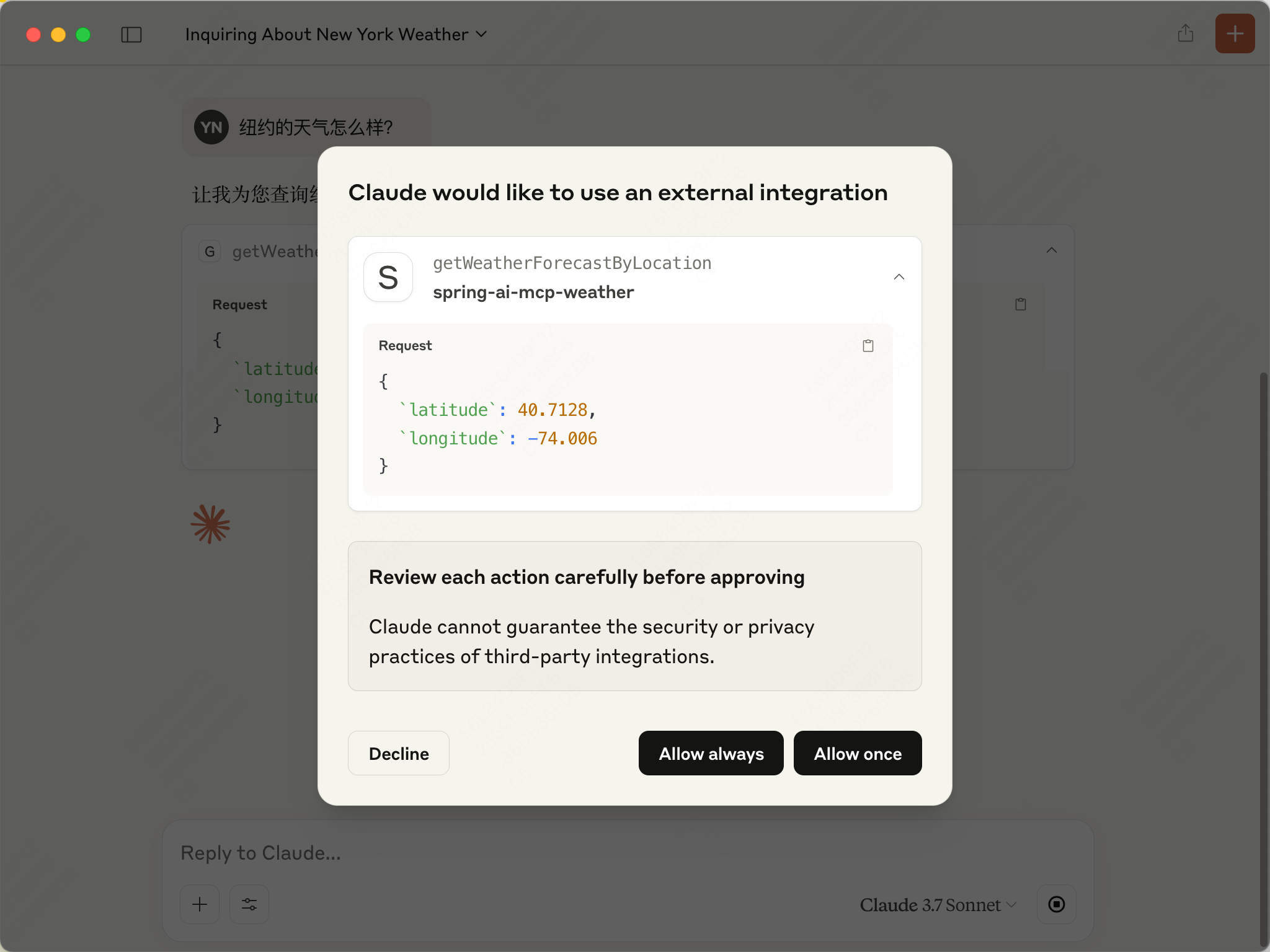
可以看到大模型自己调用了我们的工具,并展示了输入输出。
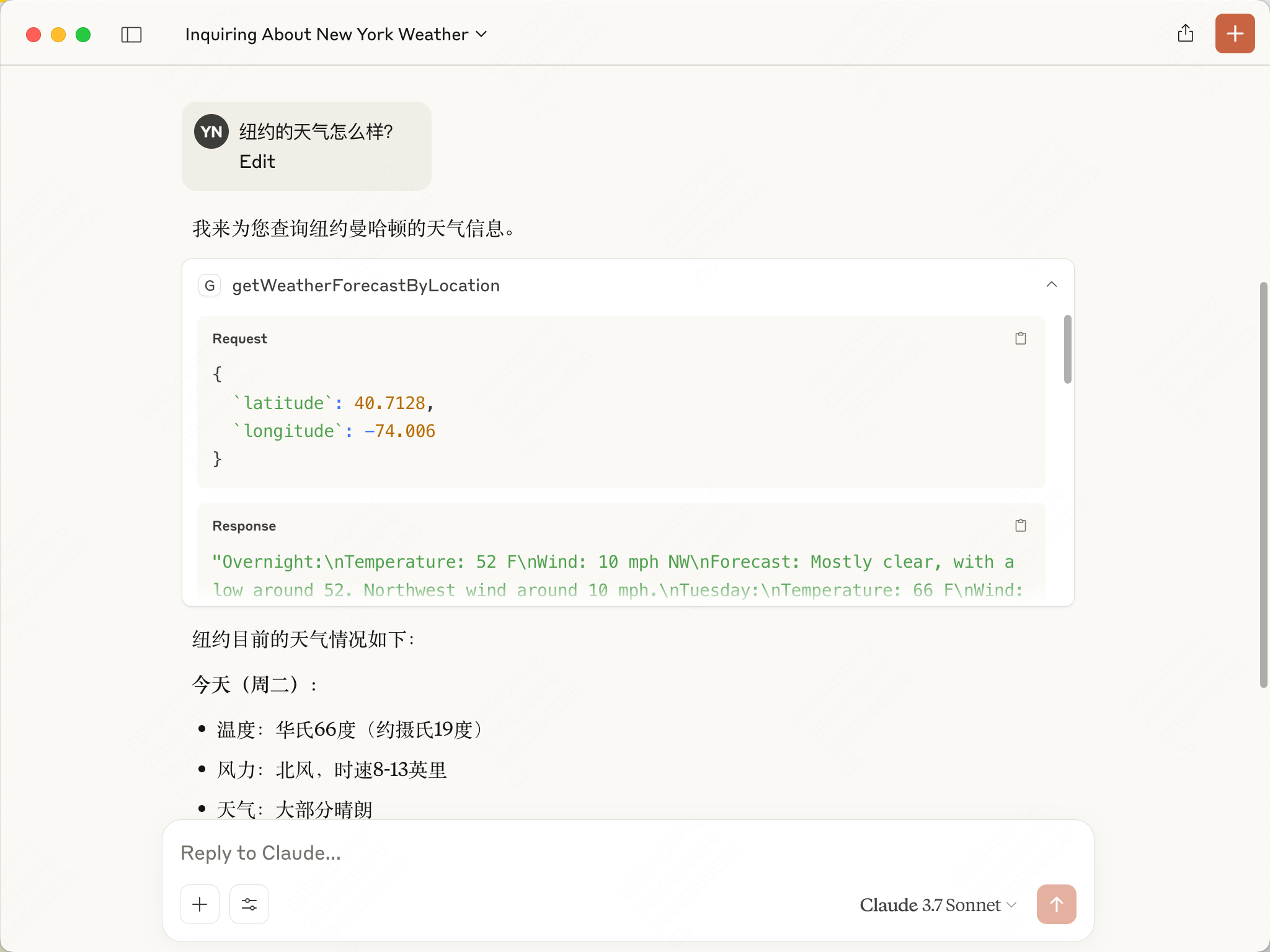
看到这里我们可以得出MCP+大模型的运行流程图。
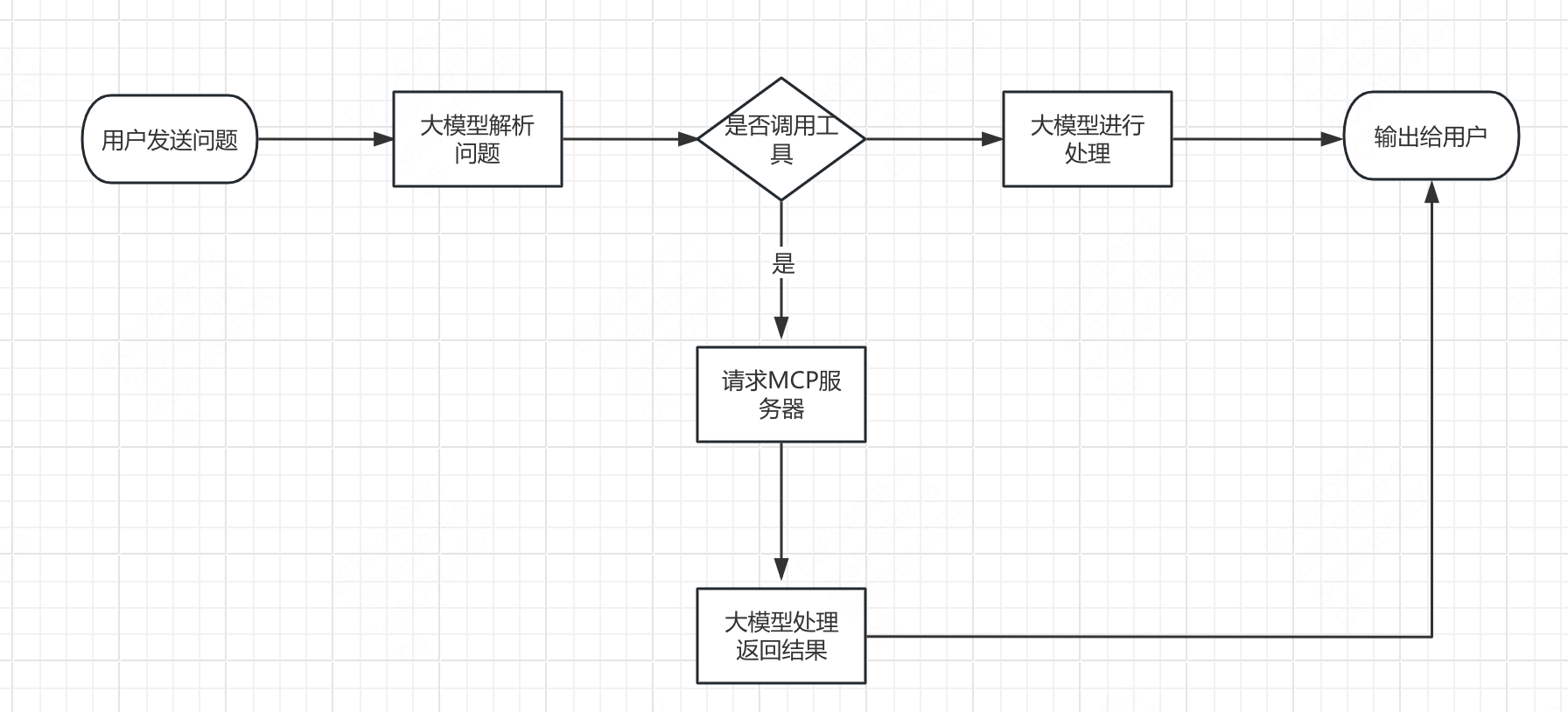
日志
如果需要查看日志信息,可以到如下目录:~/Library/Logs/Claude
有多个文件:
- mcp.log : 包含了MCP所有的日志
- mcp-server-xxxxx.log: 一个MCP服务一个日志文件,记录了这个服务相关的所有日志
总结
我们主要介绍了MCP的概念,MCP的通信协议、通信方式、生命周期。MCP到底是什么东西,实现了哪些内容,使用场景以及为什么要使用MCP。






















 9371
9371

 被折叠的 条评论
为什么被折叠?
被折叠的 条评论
为什么被折叠?








